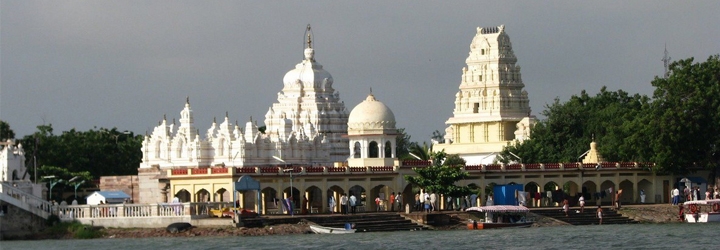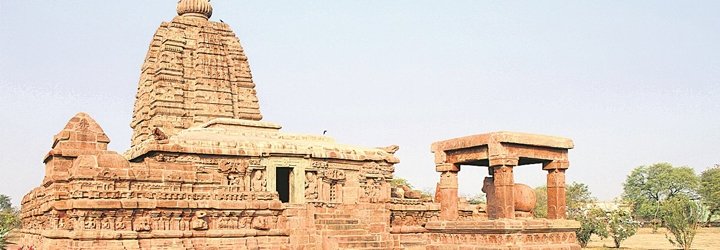At a distance of 218 km from Hyderabad, 22 Kms from Kurnool, 126 km from Mahbubnagar & 200 km’s from Srisailam, Alampur is a historical place located in Mahbubnagar district of Telangana. Alampur is popular for Jogulamba Temple (a Shakti Peetha), Nava Brahma temples and Sangameswara Temple built in the 7th century. Alampur is considered as the western gateway to the popular pilgrimage town Srisailam. The temple consists of several inscriptions dated between 7th and 16th centuries. Alampur is one of the famous places to experience Telangana tourism.
Places to visit & things to do in Alampur
Vishwa Brahma Temple

At a distance of 1 km from Alampur Bus Station, Vishwa Brahma Temple is the best-preserved temple after Bala Brahma temple among Nava Brahma temples. This temple hosts wonderful carvings throughout the structure.
Located towards northern corner opposite to the museum beside Vira Brahma temple, the architecture of this temple resembles that of Galaganatha Temple in Pattadakal. The temple boasts a large maha-mandapa with 18 pillars followed by the sanctum. Built on an elevated platform, there is no Mukha Mandapa in this temple. Inner sanctum has a circumambulatory path for pradakshinas. The sanctum is supported by four pillars with carvings of Ramayana scenes, Gandharvas, Lions, etc. The ceiling has wonderful carvings of Nagabandha and lotus. The doorway of the sanctum has images of Gajalakshmi, Ganga, and the Yamuna along with their vehicles Crocodile and Tortoise.
Archeology Museum

At a distance of 1 km from Alampur Bus Station, Archeology Museum situated at the entrance of the Bala Brahma Temple complex houses wonderful collection of sculptures and inscriptions recovered from the Nava Brahma Temples and surroundings of Alampur.
Started in 1953 by then Vice President of India Sarvepalli Radhakrishnan, the museum consists of 188 sculptures and 2 inscriptions. These artifacts are dated between 6th and 16th centuries. The museum is a large hall with an open air section at the center and a small enclosure towards the eastern side. All the artifacts are spread across the hall.
Kudala Sangameshwara Temple

At a distance of 1 km from Alampur Bus Station, Kudala Sangameshwara Temple is the most magnificent of the temples at Alampur. It was built in 740 AD by Chalukya ruler Pulakesin II.
The temple was originally located at the point where Tungabhadra and Krishna Rivers were merged, 10 km away from the current site. The temple was dismantled and built exactly wordpress rock-to-rock in the current site in 1979, as the original site was getting submerged due to the construction of Srisailam Dam.
Jogulamba Temple

At a distance of 1 km from Alampur Bus Station, Jogulamba Temple dedicated to Shakti is the prime religious attraction of Alampur. Being the 5th Maha Shakti Peeta, this place is highly regarded and very important religious site for Hindus. Situated past Bala Brahma Temple, this temple was destroyed by Bahamani sultan in the 14th century and the deity was moved to Bala Brahma temple. The current structure was built in 2005 on the original site and the deity was moved back to the temple. Adi Sankaracharya installed Srichakra in the original temple in the 8th century which could not be recovered after destruction.
Bala Brahma Temple

At a distance of 1 km from Alampur Bus Station, Bala Brahma Temple or Bala Brahmeswara Temple near Jogulamba Temple is the largest and most striking temple of the Nava Brahma group of temples. This is the only temple where the majority of the sculptures are found in good shape.
Built in the 7th century by Chalukya ruler Pulakesin II, the temple had several additions during Vikramaditya period in 755 AD. Constructed in Nagara style, the there temple has the large pillared verandah on all sides for outer pradakshinas. The temple has large Mukha Mandapa, maha-mandapa, and sanctum with the circumambulatory path for inner pradakshinas. The shiva-linga in this shrine is seen in the shape of a bull’s footprint.
Padma Brahma Temple

At a distance of 1 km from Alampur Bus Station, Padma Brahma Temple is situated behind Swarga Brahma Temple. The tower of this temple was destroyed by the invading Bahamani Sultan army in the 14th century and most of the sculptures were removed.
This temple has a large hall, inner sanctum and circumambulation path for pradakshinas around sanctum. The doorway of the sanctum has carvings of Ganga and Yamuna. Images of Ganapati, Subramanya and Kubera can be found in the circumambulatory path. The main doorway of the temple has Dwaraka Lakas and Garuda. There are carved figures of several gods and Gandharvas on the outer wall of the temple.









